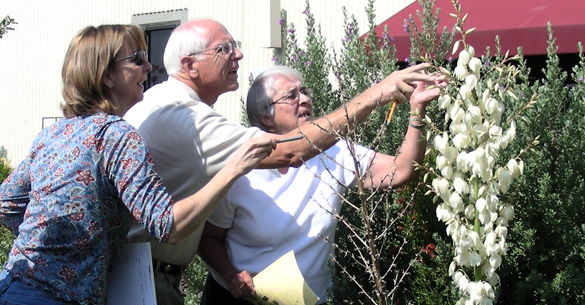Proper identification of a pest problem is needed before a control recommendation can be made. If you need a pest identified and your problem is insect-related, you can take a specimen to your county Extension office and ask for assistance from a Master Gardener, Horticulture agent or County Extension Agent. Before you do, please look over the following guidelines.
General Guidelines
- Make sure your sample consists of a discrete specimen. For practical reasons we cannot accept general household sweepings, wash water or vacuum cleaner contents, clothing or samples in more than one ounce of alcohol or other preservative.
- We are not medical doctors. Stool samples or samples taken from in the skin or other human tissue are not appropriate and will not be accepted.
- Large samples, such as tree limbs or large plants, cannot be accepted without prior approval of the identifier.
- A diagnostic form should be completed and sent with the specimen. If an insect was collected feeding on a plant, try to determine the kind of plant, or send a pressed leaf or picture of the plant with the sample.
- It is useful to know the reason for wanting an identification. Did the insect bite or sting? What it collected indoors? Was it causing any known damage?
- If your problem is due to non-insect causes, such as soil deficiencies, disease, environmental issues, or herbicide damage, you will need to contact another agency. Plant disease and cultural problems are handled by the Plant Disease Diagnostic Lab. For soil testing, contact the Soil Water and Forage Testing Laboratory. Both of these laboratories charge fees for analyzing samples.
- No more than five samples (1 oz vials, zip-loc bags with sample, sticky cards, etc.) will be accepted at a time. If more than five items are submitted, the sample will be rejected or only five items examined.
Mailing Guidelines
For more difficult identifications, you may have to prepare the specimen and send it through the mail for identification. Please follow the following rules when submitting a diagnostic sample through the mail:
- Samples should be properly protected from crushing and preserved–for most specimens (except butterflies and moths) this means placing them in a small amount of alcohol.
When mailing samples through the mail, US Postal Service regulations for shipping flammable liquids must be followed:
- Mail specimens in a leak-proof plastic jar. No more than 1 fluid oz (30 ml) of rubbing alcohol or alcohol based hand sanitizer gels should be included as a preservative, according to Postal Service regulations.
- Regulations further require that any specimens shipped in alcohol be placed in a sturdy box at least an inch larger than the jar. The jar should have some sort of padding (e.g., newspaper, Styrofoam peanuts) between it and the box, and it should also be enclosed in a second, leak-proof container, like a Ziploc™ bag. The following regulations from the U.S. Postal Service describe proper packing instructions more fully http://pe.usps.com/text/pub52/pub52apxc_045.htm Note that the outside of the box should be clearly marked with “This package conforms to 49 CFR 173.4.”
- As an alternative to shipment in alcohol, specimens can be soaked overnight in alcohol then drained and the specimen sent damp in a waterproof container. Such samples should also be shipped as described above, but do not require outside package labeling (reference: 49 CFR 173.4b).
We recommend using pencil, not pen, when filling out the collection data form. Labels written in ink may become illegible should the jar leak during transport.
Digital images
If you have a high quality digital image of the pest you may be able to submit your sample to your county extension office electronically. It is important to remember that the same information requested for actual samples must be included with your digital samples. In fact, collection information is even more important with digital images, since there is an additional layer of interpretation that must be made by an identifier using a digital sample. The minimal information that should accompany your image is city, county and state of collection, date of collection, measured length of specimen (since scale is often not identifiable with an image), abundance and the type of damage being caused. Relative abundance or degree of infestation is also important to note.
Note
We currently do not charge for insect identifications. Because of the limited number of personnel that are available to provide this free service, however, we can not always guarantee a rapid turnaround of submitted samples. We do promise to provide an accurate identification as quickly as we can. Should you need a guaranteed fast turnaround, commercial fees for insect identifications usually start at around $100 per insect through private firms.

